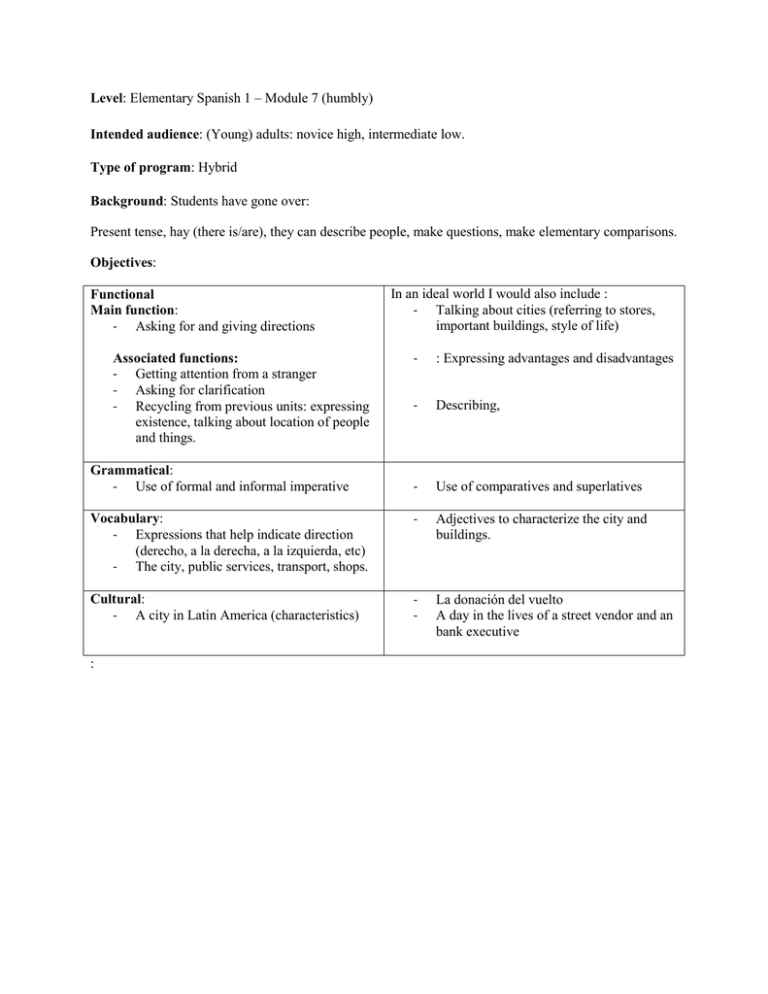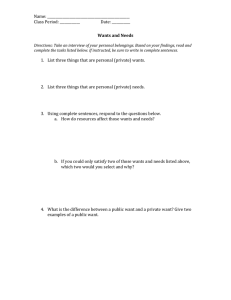Level Intended audience Type of program Background
advertisement

Level: Elementary Spanish 1 – Module 7 (humbly) Intended audience: (Young) adults: novice high, intermediate low. Type of program: Hybrid Background: Students have gone over: Present tense, hay (there is/are), they can describe people, make questions, make elementary comparisons. Objectives: Functional Main function: - Asking for and giving directions In an ideal world I would also include : - Talking about cities (referring to stores, important buildings, style of life) - : Expressing advantages and disadvantages - Describing, - Use of comparatives and superlatives Vocabulary: - Expressions that help indicate direction (derecho, a la derecha, a la izquierda, etc) - The city, public services, transport, shops. - Adjectives to characterize the city and buildings. Cultural: - A city in Latin America (characteristics) - La donación del vuelto A day in the lives of a street vendor and an bank executive Associated functions: - Getting attention from a stranger - Asking for clarification - Recycling from previous units: expressing existence, talking about location of people and things. Grammatical: - Use of formal and informal imperative : Activities Culture: Type of exercise on Hot potatoes Pre-Reading Matching exercise between numbers on the map and names of places ¿Cómo es tu ciudad? ¿Cuántas personas hay en tu ciudad? ¿Qué hay en el centro de tu ciudad? Mira este mapa turístico. ¿Qué lugares ves? Reading about cities in Latin America – Santiago is an example. Vocabulary aid (can I do that? How?) (Introduction of key vocabulary for the rest of the unit) Content of the reading: - They have a Plaza de Armas in the center (Km 0) This Plaza is the core of the city The structure is like a grid – different from many European cities. There are many stores, public offices and churches This map corresponds to Santiago de Chile There are two boulevards that cross downtown There is plenty of public transportation, especially, the subway. Many different types of people meet here to do their banking, pay bills, go to the notary, do their shopping or eat. Exercise: Listen to the questions about the reading and select the right answer. 3-4 Multiple choice questions with 3 options Listening: Estamos perdidos en Santiago (We are lost in Santiago) First part of the conversation is also written Two tourists asking for directions (they are in the same area shown on the map above). They ask two Put sentences in the right order 4-5 sentences different people – Get the same directions. Use the map as a reference and put in order the sentences that give the right directions Second part of the conversation: Just listening – no written dialogue. 3 Multiple choice options Look at the map again- Where do they want to go now? Structure 2 Drop down menus. One for imperatives and another for chunks/adverbs What did they say in the instructions? Focus on imperatives and chunks used to give directions. Explanation of imperatives (formal and informal) Fill in the blanks – dialogue Fill in the blanks the sentences using the formal or informal imperative Your turn to talk Can I include a feature to ask students to record? Use the map and give directions to these people That could be revised by the teacher – Some options could be included for students to listen to Use the expressions discussed (appear in a box) Writing: Write about your own neighborhood/city and describe what it is like. Use the reading at the beginning of the lesson as a reference Language meeting Prepare to: Describe your city or neighborhood Be ready to give directions in Pittsburgh Chat: What is better? To live in a small city or in a big city? Why? Prepare your arguments Self evaluation Cultural Functional Vocabulary



